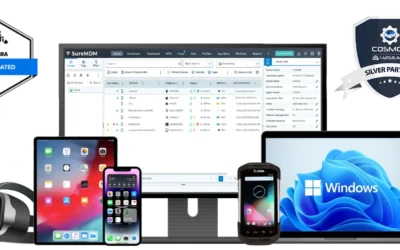Rolling out an RFID solution can be a transformative move and it doesn’t have to be overwhelming. Whether you’re exploring how to improve manufacturing processes, supply chain visibility or automate inventory, beginning with a structured pilot project can help validate the investment before scaling.
At MSM Solutions, we’ve guided customers through RFID pilots of all sizes for more than 25 years. Some begin with minimal capital outlay, while others invest six figures to rigorously test performance. Regardless of budget or complexity, successful pilots follow a consistent process that helps organizations move from proof of concept to measurable ROI.
This 12-step guide outlines the critical considerations for piloting RFID effectively—so you can move forward with confidence and clarity.

1. Confirm RFID Compatibility
Before you dive into equipment or software selection, start with the basics:
- Are your products RFID-friendly? Materials like metal or liquids can impact tag performance, though MSM offers RFID tags from a variety of vendors optimized for challenging environments.
- What tags make sense? From rugged RFID Tags for industrial use to flexible labels for retail, selecting the right form factor and chip configuration is foundational. Tag size, surface compatibility, and environmental resistance all matter.
2. Choose the Right Labels and Encoding Strategy
Labels are more than stickers—they’re data carriers. Decide:
- What gets encoded? Will labels need just an EPC number or other dynamic variables like lot number and expiration date?
- Will you print/encode in-house or source pre-encoded tags? You may need an RFID printer and encoder, or you might start with MSM’s pre-encoded and printed samples to simplify the pilot.
3. Set Clear Expectations Early
Success is easier to define—and reach—when everyone is aligned. Collaborate with your internal team and any external integrators to clarify:
- The specific process or asset to track
- The measurable goals of the pilot (e.g., time saved, errors reduced)
- The timeframe for testing
This alignment avoids misunderstandings and keeps the pilot focused on business value.
4. Select RFID Hardware That Matches the Use Case
- Mobile or fixed RFID readers or both? Mobile readers are ideal for low-volume testing or multi-site pilots. Fixed readers make sense in chokepoints like warehouse gates or loading docks.
- Connectivity matters. Do you need coax cables, wired Ethernet or Wi-Fi? Ensure your site supports the necessary infrastructure for communication and data transfer.
5. Define the System Architecture
Your RFID system will need somewhere to send data:
- Local server or cloud platform? Cloud systems can simplify remote support, while local servers may appeal to industries with strict data security policies.
- Allow integrator access. Remote support capabilities can reduce downtime and ensure quick troubleshooting during the pilot.
MSM Solution’s Portal Track offers a scalable platform that can begin with a single application and expand into a global enterprise solution. It also enables remote access, allowing system integrators to support the pilot efficiently.
6. Evaluate Software Integration Needs
Your pilot could use:
- Stand-alone software for isolated use cases such as a tracking dashboard
- Integrated software that feeds into existing ERP, WMS or MES platforms
While standalone software helps prove the concept quickly, integration unlocks greater long-term value. Portal Track can be deployed on-premise or in the cloud, and it operates as a standalone solution or integrates seamlessly with WMS, ERP or legacy systems.
7. Map the Process
A pilot without a plan is just a guess. Create a process map to visualize:
- Each step in the workflow
- Where tags will be applied and read
- What data will be captured, and where it will go
MSM Solutions offers on-site visits to map system architecture and ensure alignment with your existing process workflows.
8. Secure Internal Buy-In
Assign clear internal ownership. Most pilots need input from:
- Process managers or operations leads
- Engineers or maintenance teams
- IT for network and system integration support
Without dedicated resources, even well-designed pilots risk stalling. This often happens not because the technology failed, but because the project lacked the internal support to carry it through. It’s a common myth that RFID implementation is purely a plug-and-play solution. In reality, success depends on cross-functional collaboration and sustained ownership.
9. Define Success and Unknowns
Be honest about what success looks like:
- What metrics define a win? Labor savings? Improved production throughput and uptime? Improved inventory accuracy? Reduced waste? Compliance and Quality Assurance? Enhanced customer satisfaction?
- Does the RFID read have to be 100%?
- What’s the minimum level of complexity to prove feasibility? Some pilots only need a mobile reader, demo software and a few tags.
Knowing your targets and baseline makes it easier to scale strategically later.
10. Set a Timeframe and Budget
- Pilots can span from a few days to several months depending on scope and complexity.
- Costs can range widely—from under $1,000 to over $100,000. Right-sizing your pilot depends on your goals and the value of what you’re tracking.
11. Prepare the Physical Environment
Before go-live:
- Confirm mounting options for fixed readers
- Validate tag placement on products or assets
- Check network coverage in the test area
Proper setup prevents delays and ensures accurate reads during the pilot.
12. Don’t Overlook RFID Training
A successful RFID pilot isn’t just about technology it’s also about people. Providing foundational training helps your team understand how RFID works, why it’s being implemented and how to use the system effectively.
Organizations like RAIN Alliance and GS1 Standards offer accessible resources to help build internal knowledge around RFID technology, industry standards and best practices. These materials are especially valuable for:
- IT and engineering teams evaluating system architecture
- Operational leaders managing workflows
- Users interacting with RFID tags, readers and software
Empowering your team with the right training supports adoption, reduces user error and helps maximize the long-term value of your RFID investment.
Final Thoughts: Think Big, Start Small
A pilot isn’t just about testing RFID. It’s also about proving the value it can bring to your operations. When the pilot ends, you should be able to confidently say whether RFID can improve your operations, how much value it adds and what it will take to roll out at scale.
Want help designing your RFID pilot? Contact MSM Solution’s RFID experts to explore your application needs and tag options.


